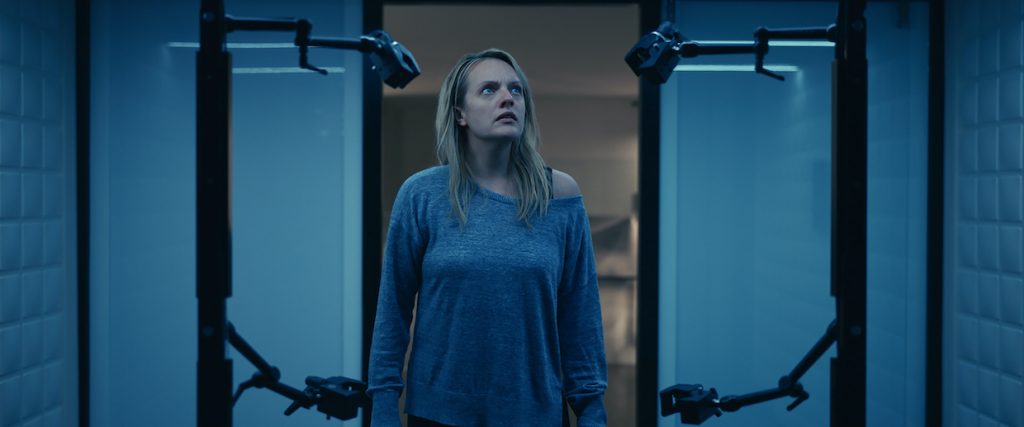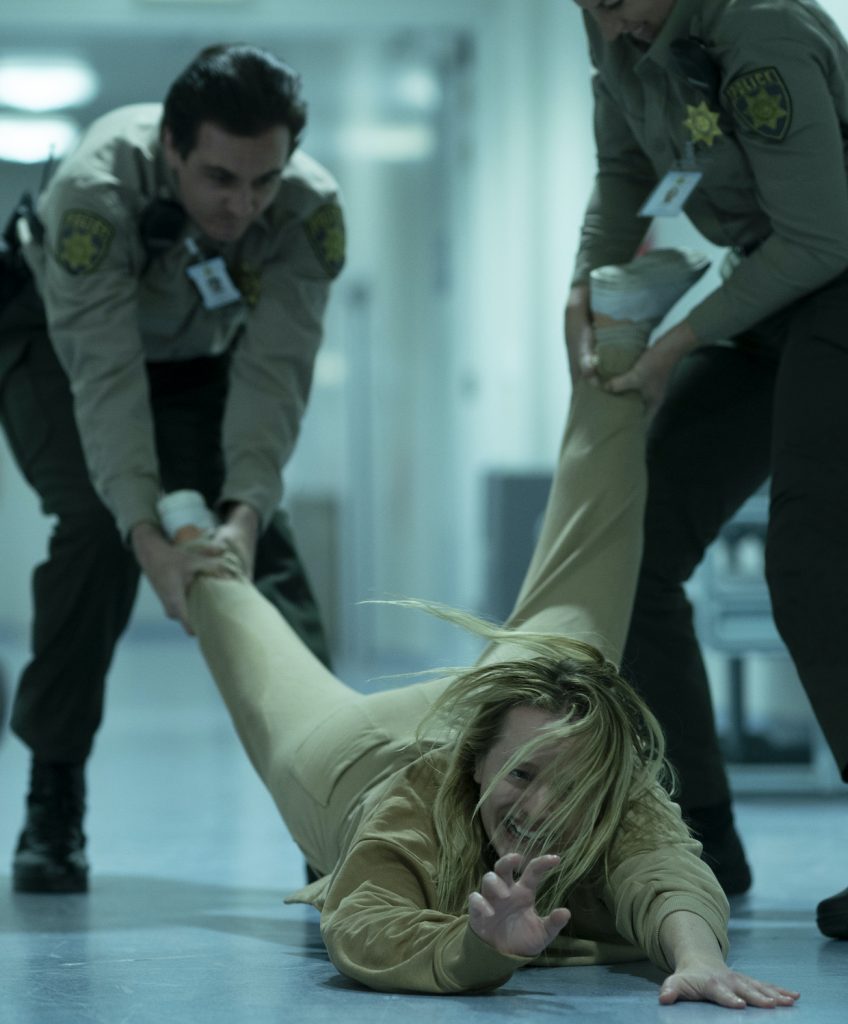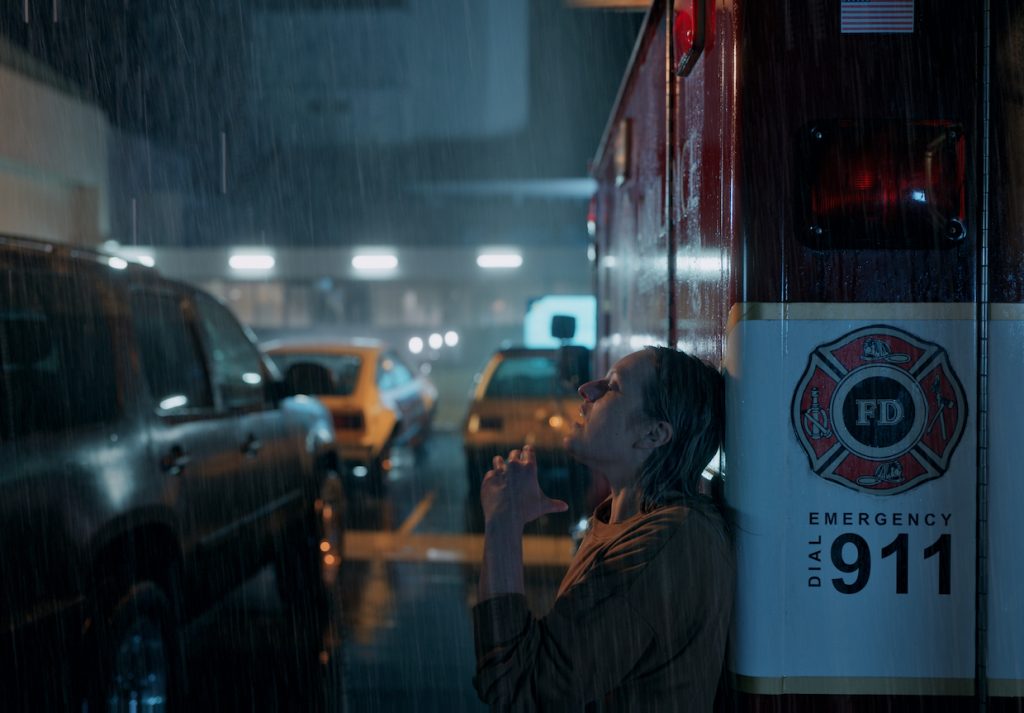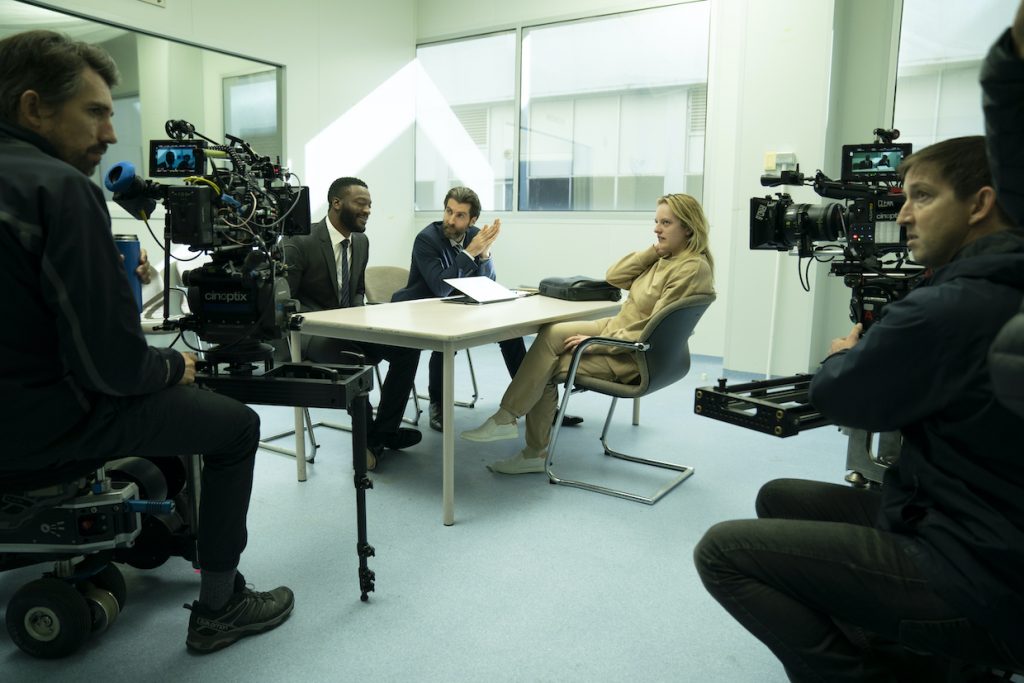 Back to selection
Back to selection
Shutter Angles
Conversations with DPs, directors and below-the-line crew by Matt Mulcahey
“All of our Frames Match Exactly on Every Pass”: DP Stefan Duscio on The Invisible Man, the Alexa Mini LF and Compositing Uninterrupted Shots
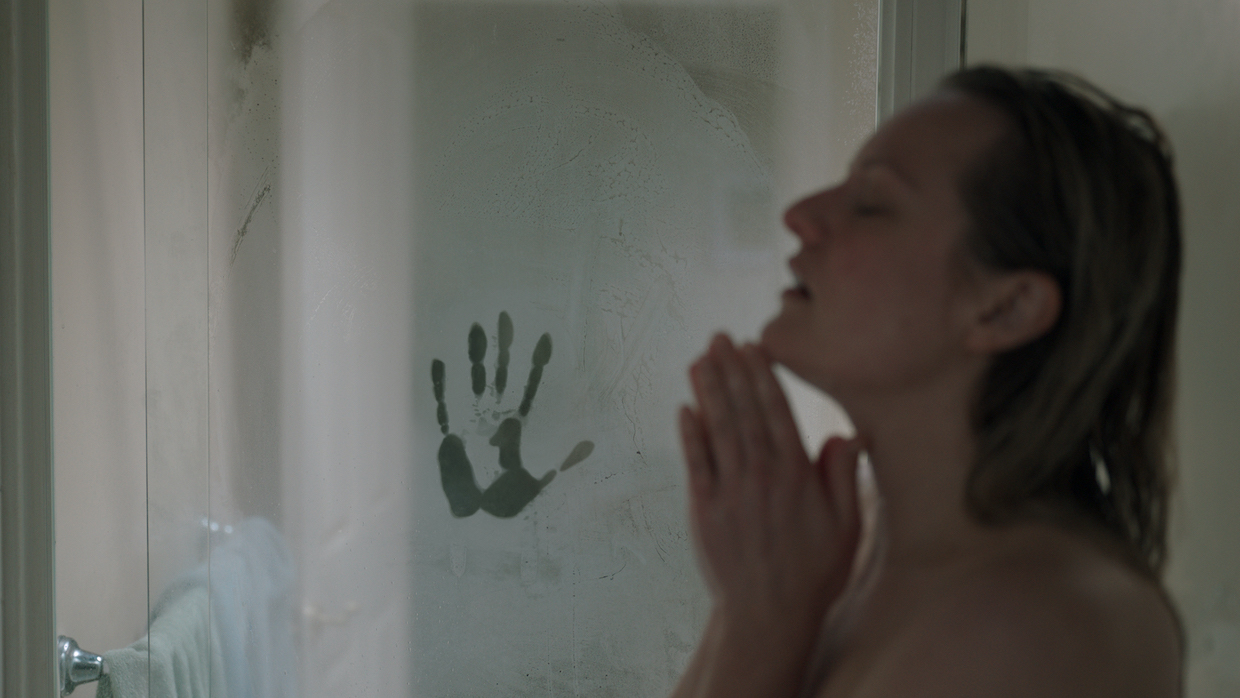 Elisabeth Moss in The Invisible Man
Elisabeth Moss in The Invisible Man The newest incarnation of The Invisible Man is not a scientist driven mad by his own discovery but a tech billionaire, Adrian (Oliver Jackson-Cohen), whose newest creation—an “invisibility suit”—allows him to silently terrorize his ex, Cecilia (Elisabeth Moss). When Adrian’s lair is revealed along with the suit’s resting place, production folks are in for a knowing chuckle—holding the suit up are a set of Mafers and Israeli arms. For the uninitiated, the former is a clamp frequently used by the grip department and the latter is an adjustable arm for attaching onboard monitors to cameras. It’s a sly bit of low-budget inventiveness that serves as a reminder that Universal’s beloved monster movie properties are now in the thrifty hands of Blumhouse after the venerable studio’s dreams of a big budget, interconnected “monsterverse” unraveled following the underperformance of Tom Cruise’s $120 million Mummy.
The Invisible Man director Leigh Whannell and cinematographer Stefan Duscio know a little something about imagination on the cheap, having created the cult favorite sci-fi action flick Upgrade. Today, their newest effort becomes a distribution guinea pig. With movie theaters across the world shuttering in the midst of the coronavirus pandemic, Universal will make three of its current theatrical releases available to stream for $19.99—The Invisible Man, The Hunt and Focus’s Emma.
Filmmaker: Before we get into The Invisible Man, I want to revisit Upgrade. In that movie, you somehow synched the camera to the actor playing Grey so that when he moves in a fight scene, the camera moves with him. How did you do that?
Duscio: Early in preproduction, Leigh tasked me with trying to figure out a unique visual way to represent an artificial intelligence taking over Grey’s body. I happened to be doing a lot of work with rotating and locking the camera to [the movement of] Olympians for a commercial I’d recently done, but I was doing that manually by rotating the head. After seeing that commercial, a friend—Andrew Johnson, who’s a Steadicam operator—told me about a camera rig called an MK-V Omega-R that allowed him to lock the gyro onto an iPhone using an app. That basically meant that I could lock on to the roll access. If you rotated the phone left or right, the camera on this Omega rig would rotate perfectly with it. We rigged the iPhone to our lead actor Logan Marshall-Green, so that when he got hit, threw a punch or rose up off the ground the camera would be locked in perfect sync and move with him. We did some tests early [with] a stuntman and quickly realized how powerful it could be.
Filmmaker: You and Leigh spend time in prep watching films together for inspiration. What was in the queue for The Invisible Man?
Duscio: Leigh screened The Exorcist for me. We screened Hereditary in a theater for a lot of the cast and crew right before we started shooting—not necessarily as a touchstone for The Invisible Man, but just because Leigh believed it was one of the finest horror films of recent memory. He wanted us to strive for greatness like that. In terms of specific references, I remember showing Leigh a couple things he hadn’t seen, like Personal Shopper and A Ghost Story, that I found quite emotionally powerful that dealt with the idea of this unseen presence. Both of those films are beautifully made and deal with emptiness really well. I loved how A Ghost Story studied empty spaces in that house. Leigh and I were trying to come upon this language of how we were going to make the film suspenseful when so much of it is just Elisabeth in a room.
Filmmaker: A Ghost Story is shot in a 1.33:1 aspect ratio. How did you decide on spherical 2.39 widescreen as the best ratio to emphasize empty space in The Invisible Man?
Duscio: In preproduction we did test both anamorphic and spherical and 1.85 versus 2.39. We found that by shooting in widescreen we had more negative space to play with in the frame as opposed to shooting in 1.85, where you tend to fill the frame more with your lead character. In widescreen you can shoot a midshot of your protagonist and still have half the image left over. The more we looked at compositions like that—compositions that felt kind of off or not quite right—the more widescreen excited us as a canvas.
Filmmaker: You said in an interview that you took more than 10,000 stills during prep for the film. How does taking those stills help you find the look?
Duscio: I often take a lot, but it was pretty unusual for me to take that many. Beyond taking stills during location scouts for the film, we previsualized via photoboards as much as we could. We would take a stand-in or two to the locations and shoot stills of how we would ideally like to shoot scenes. From those stills, I would lay out a PDF like a storyboard showing our set-ups. Sometimes, when we needed to really get specific, we shot video with stand-ins. We did that, for example, for a big sequence in the middle of the film where [Moss’s character] Cecilia escapes from a psychiatric ward. We shot video rehearsals of all of that, because we needed to break that whole sequence down for stunts, VFX and motion control work.
I love taking photos and I love printing. So for The Invisible Man, in Leigh’s office, I would print reference frames from films we liked that were evocative of the color and palette we wanted. Those went on one board and then on another board was the reality of what we were trying to achieve, our location stills photoboards. Anyone who came into the room—whether it was a producer, an actor or the art department—could see [our vision] for the film.
Filmmaker: What other movies made that “inspirations” board? I know you’re a big fan of Roger Deakins. Was he well represented?
Duscio: Yeah, it was mostly Deakins. (laughs) There were a lot of shots of Prisoners on that wall. There was Revolutionary Road—there are a lot of beautiful frames of Kate Winslet in that house in that film that I referenced. There were a few shots from Sicario. There were a few frames from Children of Men in there, but otherwise it was very Deakins heavy.
Filmmaker: You started off as a storyboard artist. Do you still ever draw boards yourself or is that just too time consuming?
Duscio: It’s a bit time consuming for me these days, but, yeah, after university I worked as a storyboard artist amongst other things. I loved drawing—I wanted to be a comic book artist when I was a kid—but also thought it was a good way to meet directors and educate myself about coverage and how a director would build a scene.
Filmmaker: For The Invisible Man, you shot Alexa LF with the Arri Signature Primes. Why did you opt to step up to the larger format?
Duscio: I’d recently shot some commercial work on the LF and the Signature Primes, a big Japanese beer campaign and some fashion commercials. I just loved the larger sensor. I shoot a lot of stills on medium format cameras, so I’m aware of what a larger sensor or piece of film gives to the dimension and depth of an image. On top of that, I feel like we should be shooting 4K as a minimum on features and the current standard Super 35 [sized sensor] Alexa doesn’t do that. I love the sensor, but I believed we needed a higher resolution finish.
Filmmaker: You also used a prototype version of Alexa Mini LF?
Duscio: We were very lucky. I have a good relationship with Arri in Australia. They were aware of some of the LF work I’d been doing and mentioned to me earlier in [2019] that they may able to get a prototype Mini LF for me. We got it just in time for our shoot. Actually, we got one a week into our shoot, which made me very nervous because I knew it was essential for us to use on our motion control work on the film, because the motion control robot that we were using [the Argo] for the Invisible Man sequences could not take the weight of a full size Alexa LF. So, it was important to have a lightweight camera for that.
Filmmaker: Did you have any issues with it since it was a prototype?
Duscio: No. I had a very minor issue in that I only had two white balance settings to choose from.
Filmmaker: Either 3200 or 5600?
Duscio: Exactly, those were it. I tend to shoot all sorts of different white balances, but that was the only restriction I had on the prototype. Because I was shooting in ArriRaw, I was able to change that [white] balance in postproduction later. But that was it. Otherwise, it ran very smoothly. I used it for all my handheld work, Steadicam and any kind of car interior work. It’s a beautiful little camera.
Filmmaker: This is more of an art department thing, but I got a kick out of the rack that holds the invisibility suit, which is made up of Mafer clamps and Israeli arms—grip and camera gear.
Duscio: I only saw them for the first time the day I walked into the set and saw that the art department had used those. But yeah, those are the sort of thing that everyone who works in film will recognize, like when they used the Steadicam on Aliens [as part of the marines’ machine gun rig]. I guess the art department thought that’d be a great thing to hold an invisible suit. (laughs)
Filmmaker: Tell me more about the process of using the motion control rig for the set piece where Moss’ character battles the Invisible Man inside the house where she’s hiding out. Basically you run a clean pass with no one in frame, then do passes with action that are all later composited together?
Duscio: Exactly. Leigh was really keen on having a man in a green suit interact with Elisabeth throughout the film, because he thought that would make her reactions and physicality a lot stronger than if she were just miming it. So, we needed the ability to shoot perfectly clean plates so that we could erase the man in the green suit in post. That meant I needed the camera moves to be repeatable. It also meant we could add many other flourishes to the frame, like a table flying across the room or things falling off the walls. Those things could each be a motion control pass just for that one piece. That sequence in the kitchen, I’m not sure exactly but it could’ve been up to 20 different plates to make that shot work. It was a real jigsaw puzzle. When Leigh and I were doing our first tests on that rig, we actually liked the artificialness that the motion control robot added, much as with Upgrade. We liked how impersonal and robotic the moves were, so we kind of leaned into that.
Filmmaker: How do you actually set the move that the Argo is going to repeat? Does it have wheels or a joystick and you walk the machine through the shot and it records that movement?
Duscio: It’s a slow process. Dan [Miller], who I’d worked with on commercials before [running the Argo], basically uses a remote control—it kind of looks like a large Xbox controller. We dial in the key frames that we want to hit throughout the move. I’ll say, “Okay, at zero seconds we want the lens to be here,” and Dan and I would frame up that shot with his joystick. Then we would say, “At the five second mark we need the shot to be here,” guide the robot to that frame, then wed guide it to the ten-or eighteen-second mark. The robot smooths out the movement [between those key frames]. It was a pretty complex process because maybe after your first pass you watch it and it doesn’t feel natural enough—it was a fine line between looking too robotic. It took us time to find the right balance.
Filmmaker: There’s a scene in an attic where Moss’s character dumps a can of paint onto the Invisible Man, thus revealing his form. That whole house was a set and you couldn’t fit that Argo rig up in the attic portion. How did you achieve that shot with the rig?
Duscio: Leigh really wanted the motion control rig for that shot, but given how difficult it would’ve been to put it up in an attic—it was such a small piece of an attic we built above our set—it would’ve been really impractical. So we essentially locked the camera off and did many passes. One pass might’ve been Elisabeth throwing paint at a man in a green suit, one would’ve been empty, one would’ve been of the man in the suit screaming. That one was simple in the end, actually one of the only Invisible Man shots we locked off.
Filmmaker: Let’s talk about another sequence that utilized the motion control camera, when the Invisible Man breaks into the mental hospital where Moss is being held. There is one particularly long shot where the titular character takes out an entire hallway of guards. You stitched together multiple shots to create this extended, seemingly uncut take.
Duscio: Leigh was really keen to keep as much of that sequence in one shot as possible. We rehearsed for weeks with our stunt coordinator Harry Dakanalis at his studio. The early iterations were akin to Upgrade, where it was really heightened and the camera rotated a lot. It’s a process of discovery, really. We started with some pretty fantastical moves and stunt work, then kept trying to bring it down back more into the real world. You could argue there’s still some stuff in there the Invisible Man does that is a little bit beyond his means, but we couldn’t resist because it was so much fun to design that sequence.
Filmmaker: What goes into stitching shots together on your end of things? In 1917, there are some transitions that are obvious where you’re going into the dark of an underground tunnel, but many of them were completely seamless to me. How do you do that? Do you basically overlap the head and tail of each shot you’re going to stitch?
Duscio: Yeah, we do overlap everything a bit. Because we are on motion control, it’s much easier to blend compared to how they would’ve done it on 1917 off of a Steadicam or dolly, because all of our frames match exactly on every pass.
Filmmaker: Say the motion control rig is set up for five key frames in a move. When you set up the next piece to be stitched together, do you start on the final key frame of the previous shot so you’re stitching them together at a point of identical frames?
Duscio: Exactly. We pretty much shot the scene two stunt men at a time. The Invisible Man would take out two stuntmen, and after we completed that we would move on to the next two guards and that would be another pass. But even within each set of guards, there might have been six passes to get squib hits or clean plates or a man in a green suit. It really enabled us to make the stunt work better and feel more real by letting it just play out as one shot [in the movie].
Filmmaker: Once Moss’s character is out of the institution, there’s another extended set piece in the hospital parking lot at night in a torrential downpour. What are the challenges or lighting a space that big and dealing with these huge rain towers?
Duscio: It was very challenging for all of the reasons you just mentioned: working in the rain, at night, doing very long takes. We would do a Steadicam shot of Elisabeth for a minute to 90 seconds, following her out [of the hospital] and then weaving her way through a car park. It takes a lot out of everyone every time you roll the camera. It’s grueling for Elisabeth and our Steadicam operator. We were also trying to ride that fine line of having it be dark, yet being able to read Elisabeth’s performance.
That was another sequence that Leigh and I previsualized on my stills camera. We also shot video of it that we cut together, so when it came to shooting it on the night, it was very much about executing something we’d spoken about a lot. I also draw a lot of overhead maps, so I’m able to distribute those to our grip and electric and camera team and art department, so everyone is aware where the camera is pointing and where’s safe. I’m big on trying to give people a lot of information for logistically difficult sequences like that. [Click here to see drawings of the overhead floor plans, as well as a full shot list for the sequence in question.]
Filmmaker: What did you use to get the look of those warm sodium vapor streetlights?
Duscio: We used a combination of real sodium vapors, which we were able to hire by the art department and install in the car park, and then I used Arri SkyPanels set to (replicate) sodium vapor.
Filmmaker: Well, that’s all I’ve got for you. Is there anything we didn’t talk about that you’d like to get into?
Duscio: One of the big things Leigh wanted me to do on the film was unmotivated camera moves. He really wanted the camera to know more than Elisabeth and more than the audience all the time. So, in seemingly unmotivated ways, the camera would leave her in a scene and wander down a hallway, find something and sit there, then wander back to Elisabeth, which made for a very unsettling feeling. And hopefully audiences are so savvy now that they’re be waiting to see something [in those empty spaces]. That was something Leigh and I talked about a lot: how do we use the camera to add tension to this? For example, in the scene where Elisabeth [is interrogated by the police], during her dialogue we pushed her out of focus and the camera tilts up past her and just holds on a corner of the room. It felt so wrong as a camera operator to put Elisabeth out of focus while she was saying amazing dialogue and just be on an empty white wall. I’m like, “This could be really great or really bad.”
Matt Mulcahey works as a DIT in the Midwest. He also writes about film on his blog Deep Fried Movies.
